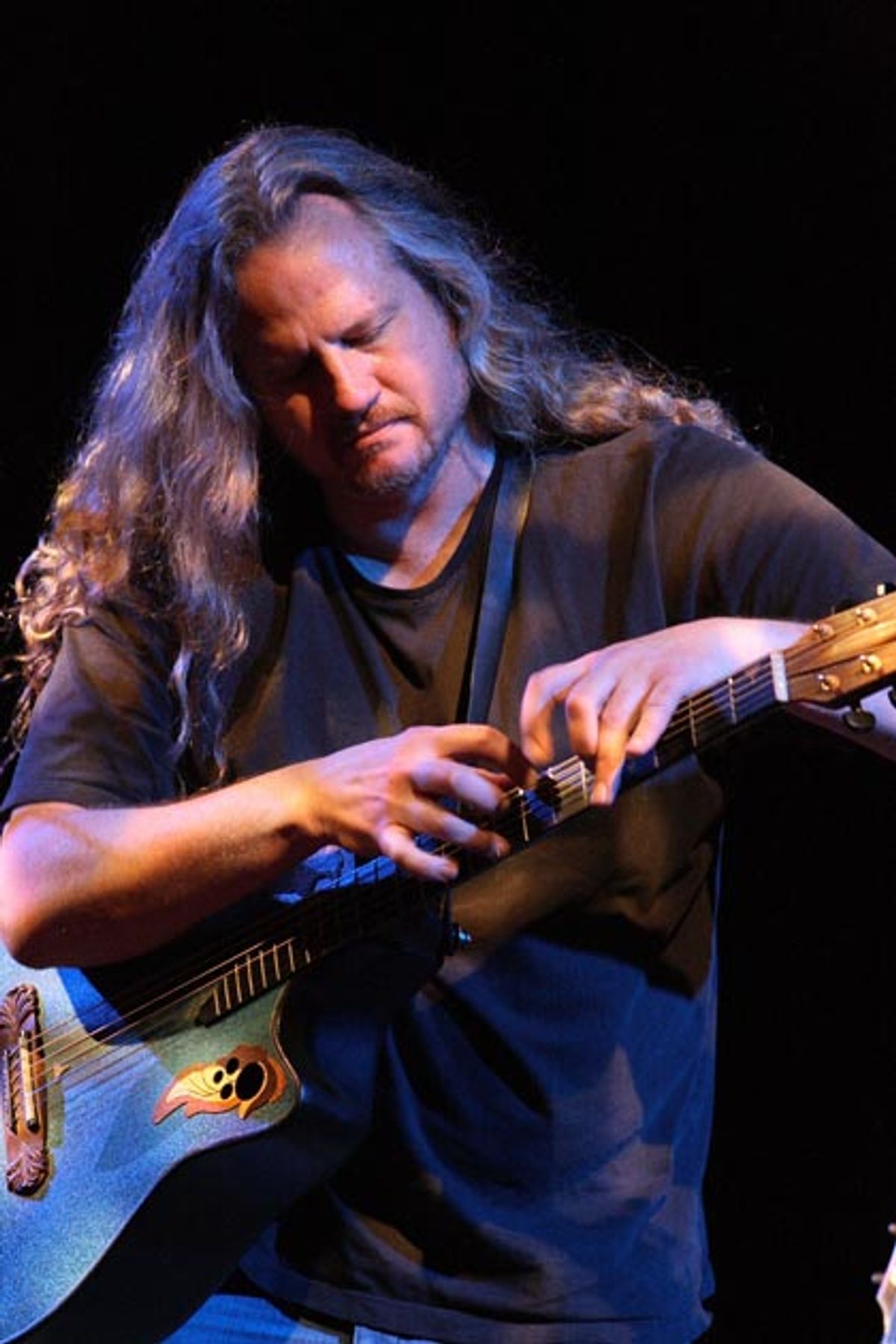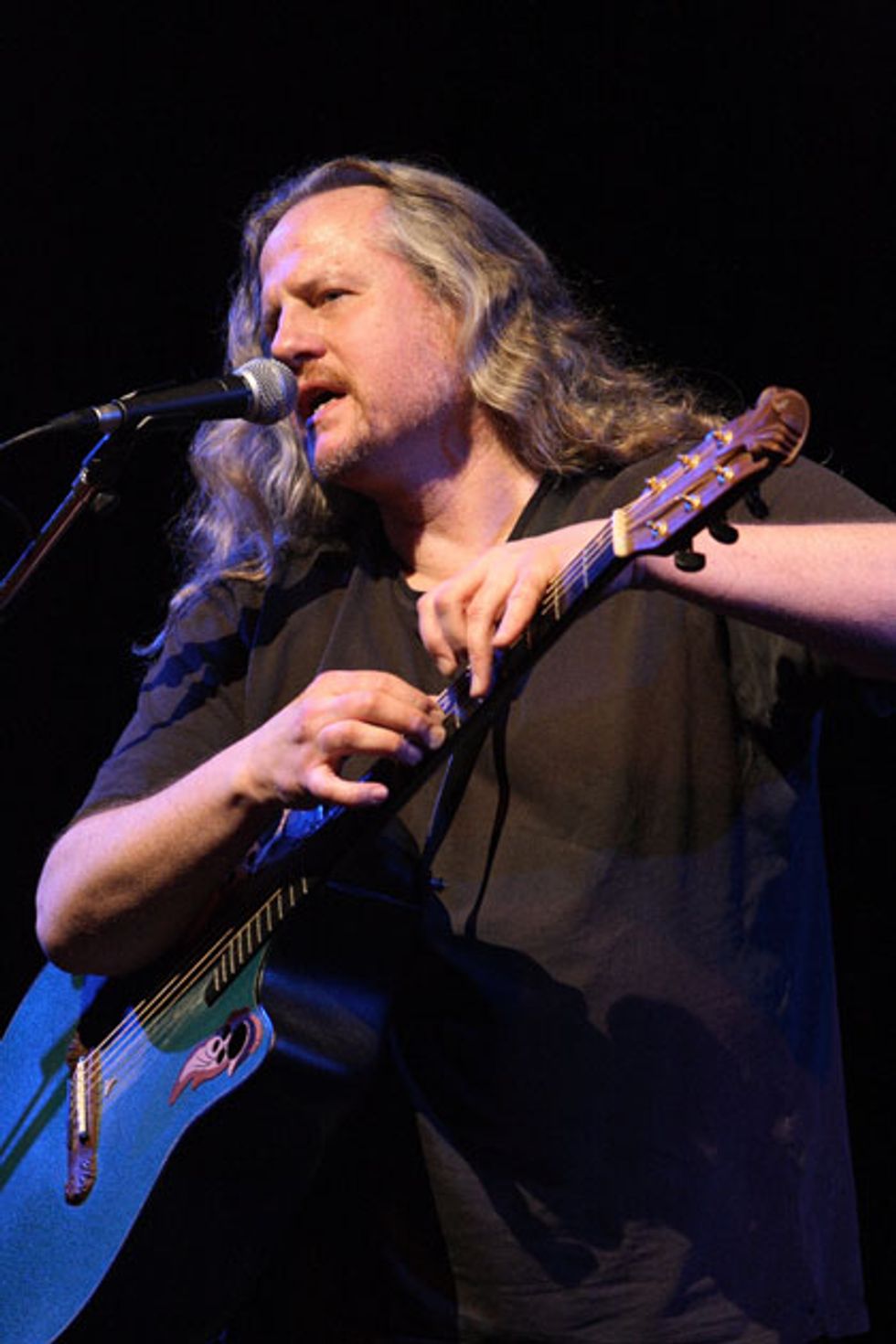The percussive fingerstyle master who inspired Andy McKee and Kaki King returns to his roots with a mind-blowing new album.
One of the most influential solo guitarists of the last two decades, Preston Reed has wowed audiences the world over with his percussive, fretting-hand-over-the-top-of-the-neck technique and directly informed such contemporary acoustic players as Kaki King (who studied with Reed at the Swannanoa Gathering music camp before her debut album) and Andy McKee. Tunes like “Ladies’ Night,” “Tractor Pull,” “Metal,” and “Blasting Cap” are required YouTube viewings, and you really can’t discuss today’s fingerstyle guitar scene without including Reed.
A New York state native, Reed spent many years in the fertile Minneapolis guitar scene before settling in Scotland in 2000. But before achieving acclaim with his notoriously percussive style, Reed honed his craft as a fairly traditional fingerpicker, putting out five albums (starting with 1979’s Acoustic Guitar) before debuting his now-famous techniques on the MCA Records release Instrument Landing in 1989. But while being signed to a major-label meant a growing mainstream audience, it also made Reed feel like he’d lost control over his work. After 1992’s Border Towns, he set out on his own again, independently releasing Metal—the album that would define him as a solo guitar force to be reckoned with—in 1995.
In the decade that followed, Reed was highly visible: He toured relentlessly, represented Ovation guitars at NAMM shows and clinics (for many years his axe of choice was a custom Adamas Longneck model), released an instructional video (The Guitar of Preston Reed: Expanding the Realm of Acoustic Playing from Homespun Tapes), and appeared in many magazine ads.
The last few years have seen Reed touring less in the U.S. and more in the rest of the world (in 2013 alone, his itinerary included China, Mexico, South Africa, France, and Poland). He expanded his shows to include a range of guitars, including electrics, classicals, and 12-strings, and his 2007 album, Spirit, even featured straight-ahead solo tunes played with a distinct jazz vibe on an electric archtop.
But now Reed has returned to the style he’s best known for—and with a vengeance. His latest album, In Here out There, highlights new compositions and a few old favorites that demonstrate a high level of maturity and confidence. Put simply, Reed has never sounded better.
Preston Reed's Gear
Guitars
Bailey Guitars Preston Reed Signature Baritone
Bailey Guitars Preston Reed Signature Jumbo
Amplification
Sunrise pickup and custom internal microphone blended to mono via an internal L.R. Baggs Dual Source preamp
D-Tar Solstice preamp
Strings and Picks
Custom Ernie Ball Phosphor Bronze Everlast set, gauged .013, .017, .026, .036, .046, .058
Rather than trying to break new ground, In Here out There seems like a continuation of what you’re best known for doing.
It really is. The new ground I broke was really with the two previous albums. It was high time for me to get back to playing acoustic, because it had been 12 years since I’d made an all-acoustic record with my integrative percussion guitar playing being the main thing.
Did you re-record some of your earlier tunes mostly to make them available again, or did you want to add some new twists?
I have a long-term agenda of getting my stuff back from a major label that basically put albums I’d written, produced, and performed into a vault. I’ve tried to get them back, but they won’t—because major labels just never do that. The next best thing was to just re-record them.
Another agenda is pushing forward with my integrative percussion guitar playing. There are some new compositions, like “Border Reivers,” which is in 5/8 time—it’s the first time I’d ever played in 5/8. And then there’s “Moonlight Race,” which is in 7/8. I think seven is just about my favorite time signature to play in. And then there is “Delayed Train,” which is sort of a remake of a tune called “Train,” but using digital delay, which somehow really enhances it.
What tunings are you using?
I’m still playing the tunings I’ve pretty much always used. On the baritone guitar, the tuning I use a lot is Bb F C F F C [Ed. note: The same tuning on a standard-scale guitar would be a whole-step higher: C G D G G D.]. That tuning really works well for my style, because it’s really a power chord with a IV on the bottom, so it becomes really easy to write tunes where the tune is in the key of the power chord, and then you can develop it by suddenly showing the big IV sound with the bottom end.
A variation of it that I use a lot is Bb F C F G C, where you’re tuning the second string up. Then there’s a beautiful tuning that “Far Horizon” and other tunes of mine are in, and that’s where you take the tuning I just told you about, but you drop the low string down one half-step to B.
What are your main guitars now?
They’re made by Mark Bailey at Bailey Guitars in the U.K. I met him when I first came to Scotland and played at the Kirkmichael International Guitar Festival. He lived nearby all those years, and three years ago it was just time to retire the Ovation. It was becoming unreliable—the electronics were getting old—but there were things about it that I really liked. So I went to him and said, “If I gave you a design for an acoustic guitar, would you build it?” He said “sure,” so I brought him all the dimensions and the characteristics that I loved about the Ovation.
Which parts of the Ovation design did you want to retain?
The neck and the way it balanced, and I wanted the body to sort of taper so that I could keep it close to me in the places that I wanted it to be. The result is this wonderful guitar I’m playing now, which is the prototype for the Preston Reed Signature Baritone. I also wanted to get a normal guitar, so he built me a standard-sized jumbo using the same kind of design specifications, but a little bit smaller. I used both of them on the album, and I tour with both of them. They have very different characteristics: The jumbo is great for playing funky tunes—it has a very punchy midrange, and I love it for tunes like “Funkin’ at the Junction.” The baritone is kind of a gentler, more beautiful-sounding guitar. But sometimes you don’t want so much emotion—you want more aggressive punch.
What’s the scale of the baritone?
It’s 28.35 inches.
What woods do the two new Bailey guitars use?
The baritone has a cedar top and mahogany back and sides. The jumbo has a spruce top and mahogany back and sides.
How did you originally get into the two-handed tapping approach?
I started off playing a lot of 12-string, and I was quite influenced by Leo Kottke, John Fahey, and Jorma Kaukonen. Those three were the core of my early guitar influences. Learning how they played gave me a really good foundation in a wonderful and powerful guitar style that I love and still use a lot in my compositions.
But in the late ’80s, I started to feel bored with just doing the fingerpicking. I was watching what Michael Hedges, Eddie Van Halen, Jeff Healey, and Stanley Jordan were doing, and I think it gave me an itch to make my mark with something. I said to myself, “How can I play drums and guitar at the same time?” I had always noticed that the acoustic guitar makes these awesome drum sounds, and depending on where you hit it—just as with any other drum—you get all these different timbres and textures and sounds out of it. With the exception of Michael Hedges and maybe flamenco people, that percussive aspect of the guitar was being completely ignored. The only thing guitarists were focused on was the sound of the strings, and that just seemed tragically limiting.
I knew I was not going to be able to do an integrated drum rhythm while playing the guitar normally, because both hands are already busy fretting and picking strings, so I went, “What would happen if, instead of trying to add drums to guitar playing, I started off playing a drum beat on the guitar, pretending I was a drummer, and then negotiated the strings into that?” Part of it might be that I’m left-handed but have always played right-handed, but for some reason my left hand just really took to playing above the neck. It made it easier to play percussion on the neck and upper bout, and I almost instantly started to play bass lines with my left hand. Then I was able to use the upper strings with my right hand to do some syncopated strumming.
YouTube It
Preston Reed demonstrates his renowned two-handed tapping technique on “Funkin’ at the Junction” from his new album, In Here out There.
When you write a tune, do you immediately go to a two-handed technique as you develop the piece, or do you come up with a musical idea first and then figure out how to play it?
I just let myself drift and experiment. My favorite kind of composition is a blend of different techniques, only one of which is going to be the hammer-ons and pull-offs over the top of the neck. It works best to have compositions that have different sections to them, like in “Moonlight Races.” It starts off with fingerpicking and then goes off into percussive stuff and drums, and then it goes into the integrated percussive, two-hands-over-the-neck stuff.
I’m really glad to have had the foundation of more traditional fingerpicking, so when I started playing over the neck it gave me another sound I could employ to make the composition more varied and interesting.
What tips do you have for players who wants to explore a similar style?
What’s important is to be really aware of what kind of a tune it is. If you want to make a rocking, grooving tune, then the most important thing to pay attention to first is the groove. Before you even get into developing a melody or a harmonic progression, the very first thing you want to pay attention to is the rhythm. When I’m writing a tune like that, the first thing I look for is a bass line and a combination of bass and percussion that feels really good. It’s like building a house—you create the foundation before you build the house.




